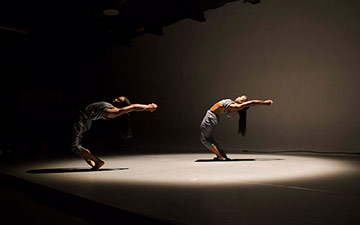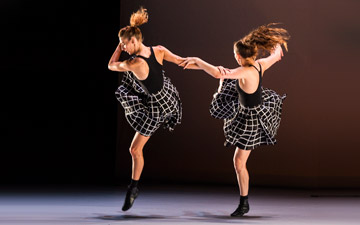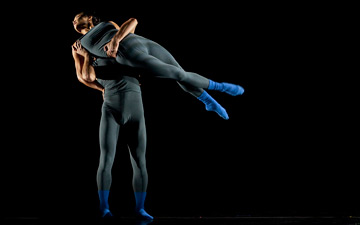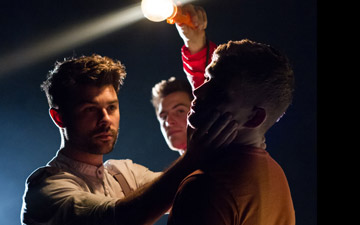
© Driftnote. (Click image for larger version)
Alleyne Dance
The Other Side of Me, A Night’s Game
★★★★✰
London, The Place
3 April 2019
www.alleynedance.com
www.theplace.org.uk
She ain’t heavy, she’s my sister. A feminine twist on the Hollies’ vintage pop song could so easily sub-title this double bill by Alleyne Dance, the performance vehicle for two of the hottest properties in contemporary dance: twin sisters, Kristina and Sadé Alleyne. They are charismatic, powerful and arresting performers; their dance encompasses recognisable elements of many genres – you can see the influence of hip-hop, flamenco, ballet, kathak, Afro-Caribbean and more – and they switch moods seamlessly from feral intensity to sensual softness. All dancers are athletes, but few are as impressively athletic. They tell big stories as themes without detail. They are two sides of one of a kind.
The evening opened with a somewhat incongruous, but nonetheless pleasant, preamble of a brief set of danced exercises – entitled Murmuration – for The Place’s Over 60s group, comprising a dozen women, performing to interesting live music by bobby demers. The ensuing double bill combined a new work by and for the Alleyne sisters – The Other Side of Me – and A Night’s Game, which they have been touring internationally, since 2016.
The Other Side of Me is an apt title for a work by near-identical twins and is itself a piece in two distinct parts. Ten large-scale illustrations (by London-based artist, Genevieve Edwards) are presented at different heights, against the back wall, sketchy and without detail, like charcoal outlines, each depicting two naked women in diverse poses suggesting a close and mutually supportive relationship devoid of any sexual significance.
To begin with, the action onstage suggests anything but such harmony. Instead, it’s a comic parody of clothes’ envy. Kristina rummages in a pile of garments, while Sadé stands facing the audience. Without looking at her sister, Kristina puts on a top (say, a mustard coloured shirt) only to find when she looks up that Sadé has removed her outer item of clothing to reveal the same shirt. This happens several times, as Sadé peels off the layers and Kristina becomes increasingly irritated; before they fight over the clothes’ pile as if manic shoppers at the New Year sales.
A line of white tape runs diagonally across the black stage, dividing it into two equal triangles. For a while it seems that the sisters are in parallel worlds, or on either side of an unseen mirror, particularly when dancing in unison, but soon they cross the divide and become combative, facing off against each other in a struggle that ends up with clothing being pulled off and, in discrete low lighting, one of the sisters is stripped topless; cowering away from the audience, revealing the topography of a beautiful, muscular back. From here on, the mood changes dramatically, slowing to a much gentler pace: wearing transparent white costumes, slashed up both sides, the sisters replicate the intimacy of the illustrations in one, long, closely-partnered, largely floor-based, cuddle. There is an overt autobiographical basis to The Other Side of Me, a work about having an identical other side while still remaining fiercely individual; a work about twins.
A Night’s Game grows stronger at each viewing. It is an absorbing, energetic non-narrative work focusing on the theme of incarceration. This is evidenced during Sadé’s long opening solo, compulsively creating rhythms by foot-stamping and body-slapping, her movement centred on and around a wooden chair, as if in solitary confinement. When Kristina joins her, there is an initial aura of mutual mistrust, even aggression, between them. Sadé twice jumps on and off the chair before throwing it weightily, and over some distance, to be caught by Kristina.
Lighting – designed by Salvatore Scollo – plays a key part in both works, whether throwing up menacing shadows or creating a ceiling of light to emphasise the loss of freedom; and an eclectic musical soundscape, interspersed with silences, is also common to both pieces, including original compositions by Alan Dicker and Tom Neil.
Both sisters were competitive athletes before turning to dance and catching a flying chair is just one of many signs of their mutual sporting prowess throughout the programme. They jump as if spring-heeled; are flexible and light-footed but also strongly weighted into the ground. They have impressive core strength, evidenced in many ways, not least by falling to the ground and using stomach muscles alone to leverage back onto their feet. Kristina encores that trick several times as the lights fade on their concluding work, ending – in total – well over 80 minutes of intense, draining, physical effort.
Like athletes in an Olympic final, they gave everything to the cause, and when the lights came up for a deserved standing occasion, the sisters were held together in a clinch. It was, no doubt, a joyous hug but it was also two exhausted women clinging to each other in the closest bond of mutual support.

















You must be logged in to post a comment.